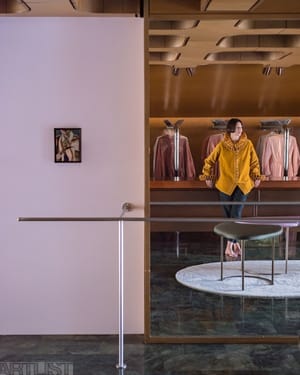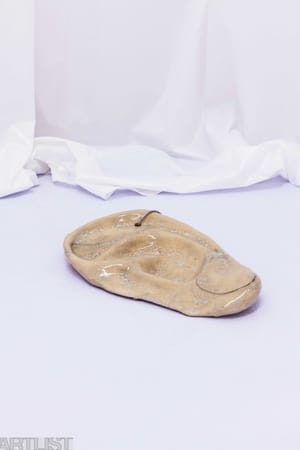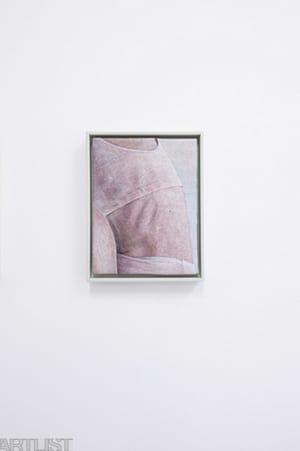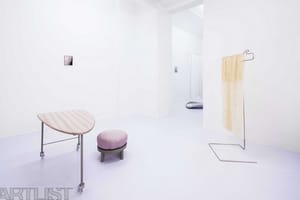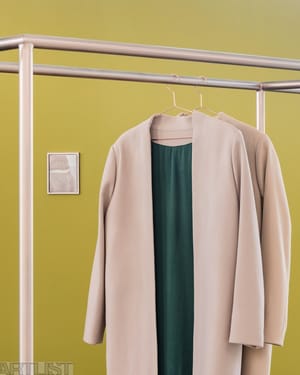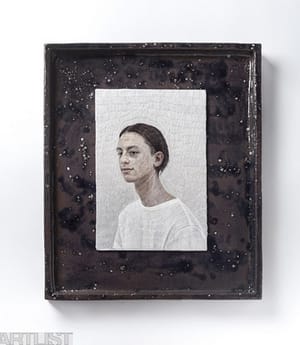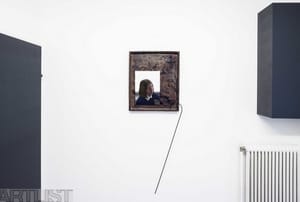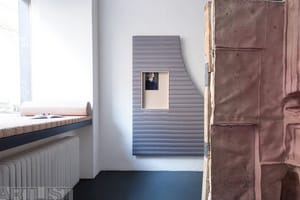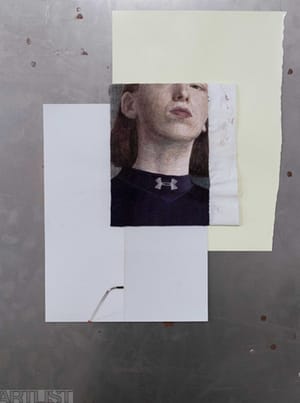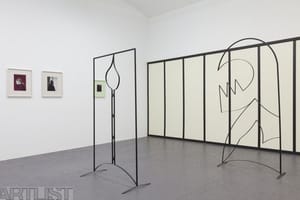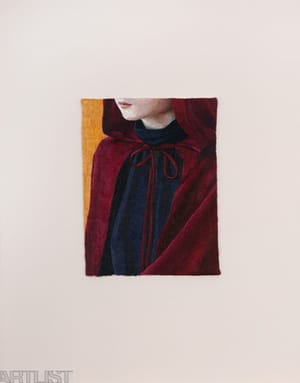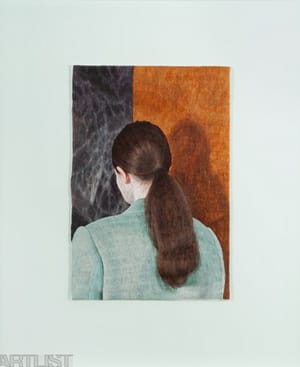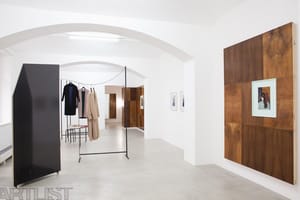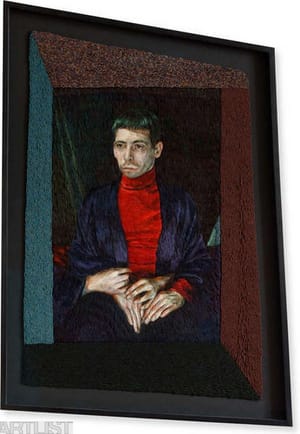- First Name
- Klára
- Surname
- Hosnedlová
- Born
- 1990
- Birth place
- Uherské Hradiště
- Place of work
- Berlín
- Keywords
- CSU Library
- ↳ Find in the catalogue
About artist
Klára Hosnedlová studied painting with Vladmír Skrepl. However, she had already begun to explore installations and embroidered images, a trend she continues to this day. Her work is realised within the context of fine art, though it also acknowledges a debt of gratitude to fashion, textile design and architecture. The layering of photograph, object, textile design and architectonic framework is manifest in the very process of creation. The exhibition VOGL (2016) was inspired by a Loos interior, which then framed the entire project, not only as a place whose modernist ethos informed the formal aspects of Hosnedlová’s work, but as the backdrop to photographed portraits that then served as a model for her embroidered images. A fragment of the wooden wall was also used as part of the installation held in the Hunt Kastner Gallery.
The functional harmony of modernist design is reflected in all of Hosnedlová’s works and her combination of different media within an integrated whole acts as a design for the eye. The project VOGL (2016) combined the time-consuming technique of manual embroidery with a hanging system for clothes and a table with photography magazines. The installation left an impression of eclecticism, while undercutting the modernist dimension with its demand for a return to manual work raised several years earlier by the Arts and Crafts movement in reaction to the industrial revolution.
In Hosnedlová’s projects, art does not serve as a cultural vanguard but rather is an integral part of a designed space in which the aesthetic function is often expanded to encompass the utilitarian. This is clearest in her work with garments, which in her installations function as part of a visual situation, as art objects, but also as products in a showroom that serve to obscure and beautify corporeality.
The theme of the showroom is also clear in the Studio Oléne (2018). In the PLATO Galley in Ostrava, Hosnedlová created a changing room whose component parts can be interpreted as art objects while at the same time fully performing the function of furniture. This installation, though it is fairly unique within Hosnedlová’s oeuvre, represents a way that art might appropriate the form and technique of applied design and refashion it into visual and conceptual stimuli, i.e. the opposite of the customer-based processes consisting of the appropriation of the approaches of the artistic avant-garde by the corporate world. In the spirit of minimalist and post-minimalist sculpture, Hosnedlová thus blurs the boundaries between free and applied arts.
However, in addition to its own decorativeness and photogeneity, Hosnedlová’s work offers another layer consisting mainly of a sensitive exposure of emotions and reflections of moods. This is most apparent in the embroidered portraits of girls that bring to mind Puberty (1894) and Melancholy (1894) by Edvard Munch. Her subjects display a kind of fascinating introversion, mainly because of the way they have their back turned to us or we see only fragments of their faces, ears, or mouths. These portraits contain a sensitive melancholy as well as self-confidence. The faces and emotions of the artist’s subjects are designed in the same way as other elements of the installation and fit perfectly. Human elements and objects merge into one world and act independently and distantly in relation to the active subject that enters the installations. We have the feeling that those portrayed are blending into the world of objects in order to conceal their shyness from us. At the same time the subjects only show themselves in incomplete form, with the face and body deconstructed into individual parts, each of which seems to live for itself with its own rhythm and tempo. The fragmentation of the body is clearly to be seen in the object Bez názvu / Untitled (2016), an oversized ceramic ear with a steel ring. It is as though the body had decomposed into parts, which had subsequently become aspects of the world of objects. In the collage Soap (2017) a hand, ear and hair presented online at artviewer.org become alienated objects with their own agenda.
An interesting aspect of Hosnedlová’s work is how she works with documentation. This often includes living people, who pose in the installations but are not part of them. This is a surviving feature of a post-internet aesthetic that lays emphasis on the documentation of exhibitions and their presentation on the internet, where they often appear better than in reality. This is a controversial claim to make: nevertheless, these days it is generally accepted that the documentation of exhibitions is often expanded by another aesthetic layer. This tends to take the form of technically precise photography, the “correct” angle from which to view a work, and postproduction, which adds to the installation a filter of something that resists the material reality on which it is based. Sometimes we have the feeling we are looking at the renders from a 3D modelling programme. Hosnedlová goes even further and includes in her documentation figures dressed in parts of the installation, such as in Ponytail Parlour (2018). What is important here is that the people are not the protagonists of a story, but part of the stage design, which means that the design of the visual situation on show includes in its objectification a person as figure.
- Author of the annotation
- František Fekete
- Published
- 2018
CV
2016–
FAVU– doktorské studium
2009–2015
AVU Praha, ateliér malby Vladimíra Skrepla a Jiřího Kovandy
2013
Ateliér Ladislava Šalouna, profesorka Nicole Wermers
2012
National University of Art, Canberra
Exhibitions
- Solo exhibitions
-
2018
Ponytail Parlour, Nová scéna Národního divadla, Praha
Studio Oléne, kutáror Marek Pokorný, galerie Plato, Ostrava
The Inhabitant (w/ Nona Inescu), kurátorka Christina Gigliotti, Polansky Gallery, Praha
2017
Soap – Special Feature, kurátor Domenico de Chirico, online at Art Viewer
Girls want to Learn, Vila Tugendhat, Brno
Yellow Morning Waistcoat, kurátorka Laura Amann, KNIZE, Vienna
2016
VOGL, (s Lucií Scerankovou, Anymade Studio a Igorem Hosnedlem), kurátor Edith Jeřábková, Hunt Kastner, Praha
Červená Karkulka (s Igorem Hosnedlem), kurátor Tereza Jindrová, galerie Jelení, Praha
Červená Karkulka, (s Igorem Hosnedlem), kurátorka by Mónica Zsikla, Gallery Horizont, Budapest
Byt doktora Vogla, instalace v bytě Adolfa Loose, Plzeň
2015
Boys Don’t Cry, kurátorka Tereza Jindrová, GAVU, Praha
2014
Baby Alone in Babylon, kurátorka Monika Doležalová, Galerie hlavního města Prahy
2013
Černé světlo, kurátor Jiří Machalický, galerie NOD, Praha
2012
Black Light, University of New South Wales, Canberra
- Group exhibitions not included in ARTLIST.
-
2018
’01’, kurátor Daniel Lamb, PM/AM Gallery Ltd, London, UK
Studio Oléne, kurátoři Marek Pokorny a Michal Novotny, galerie Plato, Ostrava
Pocta suknu, kurátorky Emma Hanzlíková & Markéta Vinglerová, 8smička, Humpolec
2017
Somebody is About to Enter (with Sonia Leimer), kurátoři Laura Amann & Jen Kratochvíl, Significant Other, Vienna
2016
Červená karkulka, kino Ponrepo, Praha
2015
Nejlepší krejčí ve městě, kurátoři Edith Jeřábková & Jiří Kovanda, hunt kastner, Praha
Boys Don’t Cry, výstava absolventů AVU, Veletržní Palác Národní galerie, Praha
2014
Jedna z možností, kurátor Milan Mikuláštík, galerie NTK, Praha
2013
Cena kritiky za mladou malbu, Galerie kritiků, Palác Adria, Praha
2012
Dekorace, galerie NOD, Praha
Současná česká malba, galerie NTK, Praha
2010
Art Fair, kurátor Dušan Zahoranský MeetFactory, Pra
Box in Art, Dům umění města Brna, Dům Pánů z Kunštátu, Brno
- Collections
- Havrlant Art Collection
